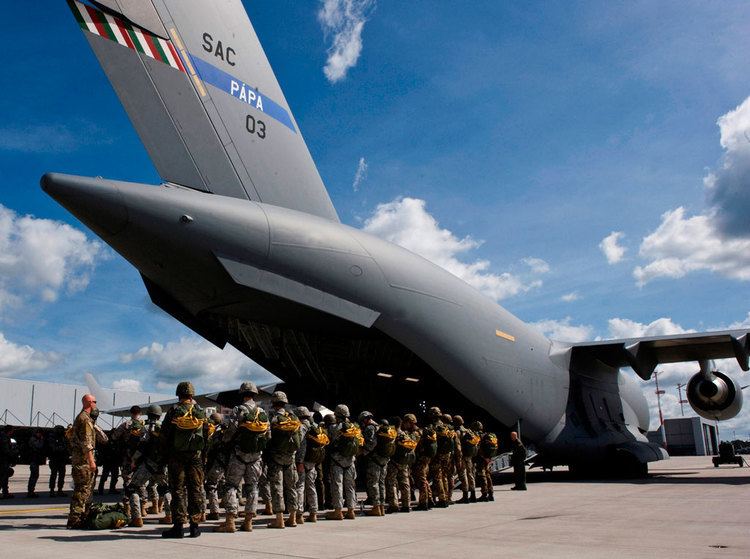Founded 2009 | ||
 | ||
Similar Baltic Naval Squadron, Allied Command Europe M, Qatar Air Force, NATO Response Force, Allied Command Transformation | ||
Strategic airlift capability
The Strategic Airlift Capability (SAC) is a consortium of 12 nations, 10 of which are member states of NATO and two of which are Partnership for Peace (PfP) members, to pool resources in order to operate Boeing C-17 Globemaster III aircraft for joint strategic airlift purposes.
Contents
The SAC concept was originally intended to be operated in a fashion similar to NATO's Boeing E-3 Sentry AWACS aircraft program, but is independent of NATO chain of command. Although the Strategic Airlift Capability relies on certain NATO support structures, it transcends the military and political alliances like the NATO and the European Union.
The operational organization of SAC is the Heavy Airlift Wing, a multinational force based at Pápa Air Base in Hungary and commanded by a colonel of a member nation. Nearly all operational aircraft maintenance is provided by a contractor team provided by Boeing. Each SAC nation jointly owns a share of the SAC aircraft, currently three in number, and acquires total annual flight hours according to its own contribution share that it may use at its own national discretion.
History
The Strategic Airlift Capability (SAC) concept originated at NATO HQ in mid-2006. NATO officials and national representatives envisaged a partnered solution that would satisfy a need for strategic airlift for member states without the economic resources to field a permanent capability. Originally this idea was called the NATO Strategic Airlift Capability (NSAC). In October 2006 the first non-NATO nation joined the initiative and the concept changed its name to the SAC and moved outside the Alliance.
On 23 September 2008 the 12 nations established the Strategic Airlift Capability by signing the SAC Memorandum of Understanding.
On 14 July 2009, Strategic Airlift Capability received its first C-17 aircraft, bearing the registration SAC 01. The remaining two aircraft, SAC 02 and 03, were delivered in the following months and operations with the Heavy Airlift Wing started immediately thereafter at Pápa Air Base.
In November 2012 the Heavy Airlift Wing achieved Full Operational Capability (FOC). The unit was then considered fully capable of missions containing air refueling, single ship airdrop, assault landings, all-weather operations day or night into low-to-medium-threat environments, limited aeromedical evacuation operations and utilizing C-17 air-land and air-drop mission capabilities.
Membership
Member states are NATO members Bulgaria, Estonia, Hungary, Lithuania, the Netherlands, Norway, Poland, Romania, Slovenia, and the United States of America, and Partnership for Peace countries Finland and Sweden.
The governing bodies of the program are the Strategic Airlift Capability Steering Board and the NATO Airlift Management Programme Board that consists of representatives of the member nations.
The SAC Steering Board exercises overall responsibility for the guidance, execution and oversight of the Strategic Airlift Capability in accordance with the SAC Memorandum of Understanding. It formulates SAC requirements and communicates them to the NAM Programme Board for execution.
The Strategic Airlift Capability has a lifespan of a minimum of 30 years and its member nations have committed to constant development of the program and its capabilities.
The aircraft and supporting equipment operated by the Heavy Airlift Wing are owned by the NATO Airlift Management Programme on behalf of the SAC Nations. The NAM Programme is the legal entity of SAC and an integral part of the NATO Support and Procurement Organization, and consists of a Programme Board and a Programme Office. The C-17 aircraft and their support were acquired from the Boeing under Foreign Military Sales (FMS) program of the U.S. Department of Defense.
Operations
The first aircraft was delivered on 14 July 2009. The C-17 Globemasters are based at Pápa Air Force Base in Hungary.
A unique feature of the SAC program is its aviation safety certification system. This system called the Concept of Total Aviation Safety (CONTAS) is based upon a heavily adapted version of the United States Air Force C-17 safety system, the principles of design and operation of heavy airlift aircraft as described by the European Aviation Safety Agency (EASA), and the mandatory requirements of the Hungarian National Transport Authority who are the national authority that registers the aircraft and certifies the operations of the HAW, and the support provided by NAMA. This system has been accepted by all the SAC nations and as such is one of the World's first true multi-national military aviation safety systems.
Deployments
The HAW aircraft can respond to a wide selection of airlift needs. The operations can include national support to EU / NATO / UN operations or national military, peacekeeping and humanitarian relief operations wherever and whenever needed by the partner nations.
Since 2009 the Strategic Airlift Capability has supported a variety of operations at its 12 member nations' requests including the International Security Assistance Force (ISAF, 2009 – 2014) and the Resolute Support Mission (RSM, 2015 –) in Afghanistan, NATO operations in Libya (2011), UN Multidimensional Integrated Stabilization Mission in Mali (MINUSMA, 2013–), the European Union military operation EUFOR RCA (2014 – 15) and the UN mission MINUSCA in the Republic of Central Africa (2015–).
Strategic Airlift Capability has also participated in the logistics support provided to the investigation of the 2014 Malaysia Airlines MH17 crash in Ukraine.
In addition to the above operations, significant humanitarian operations supported include earthquake relief in Haiti (2010) and flood relief in Pakistan (2010).
As of July 2015, the Strategic Airlift Capability C-17 fleet has achieved over 16,500 flying hours, flown over 1,200 missions, delivered over 111 million pounds (over 50,300 tons) of cargo and carried over 65,000 passengers.
Fleet
01 F-207/SAC-1 C/N 50208
02 F-210/SAC-2 C/N 50211
03 F-211/SAC-3 C/N 50212
